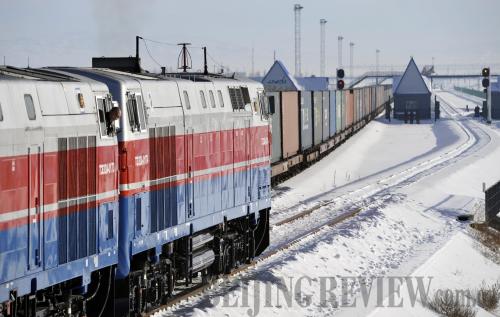|
 |
|
RAILWAY CONNECTION: A train passes through Horgos Port at the China-Kazakhstan border on December 22, 2012, the day when the second railway linking the two countries was put into service (ZHAO GE) |
Sun stressed the importance of traffic connectivity in the region. "With improved traffic connectivity in the region, economic communication among Eurasian countries will be more active and pluralistic. Their cooperation will expand from previous labor, energy, and mineral products to technological, investment, financial and service aspects, which will create great dynamism for the world economy," said Sun.
China has realized an average annual increase of 30.8 percent in trade with central, western and southern Asian countries over the past decade. The proposed economic belt will add fresh impetus to China's campaign to develop its western region and will bring an additional source of growth in its foreign trade and investment. Sun said regional cooperation will spur economic growth in related countries, boost their employment and improve livelihoods.
Historically, the Silk Road served as a bond linking the Chinese, Islamic, Slavic, Indian and Persian civilizations. It is believed that the economic belt will revive business along the Silk Road, strengthen economic ties and advance cooperation among countries along the ancient trade route, said Sun. He believed that traffic corridors established across the Central Asian region will boost trade between developed West Europe and fast-growing East Asia, link Central Asia with Europe and China, and attract more investment to the region to advance its economic development, he said.
Professor Zhou Qiren from Peking University pointed out that the world economic recovery is still slow and full of risks. Developed economies such as the United States and Eurozone members are facing various difficulties. Meanwhile, emerging economies like China maintain relatively stable development. Developing countries, especially emerging economies, have registered a 2-3 percentage points higher growth rate than that of developed economies. "Their market scale is tremendous, and their potential is unlimited," Zhou said.
The current trend of world economic integration also provides an opportunity to revive the Silk Road. The call for greater regional cooperation will upgrade the integration and restructuring of Eurasian economies.
The Silk Road was more than a trade route. As a passage linking the Eurasian continents, it contained huge cultural political, economic and cultural values. Today, the ancient passage still carries extraordinary geopolitical and strategic advantages, said Xing Guangcheng, a researcher on Eurasian studies at the CASS.
China and Central Asian countries have shared interests and destiny, and they both are at a key stage of development. Today, Central Asian countries are concentrating on economic development to realize national revival. They are actively attracting foreign investment, especially from China, hoping to have access to the huge Chinese market and share profits from China's rapid economic expansion. China, which is implementing its strategy of developing the western part of the country, is willing to promote cooperation with Central Asian countries to establish a stable and prosperous neighborhood in its west. Moreover, their cooperation will bring the two continents closer—if the land passage between China and Europe is completed, the shipping time between the two will be cut by 80 percent.
|
